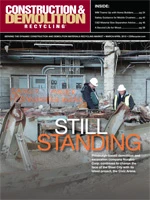|
|
America and its elected leaders seem to be having a very difficult time deciding whether the repair, bolstering and upgrading of America’s infrastructure is among its highest priorities. America’s history is rife with political disagreement, and those who have the privilege of living in countries with freely elected governments really wouldn’t want it any other way. For much of the post-World War II era, however, both major political parties have had valid reasons to support transportation and public health (water and sewer) infrastructure spending to please several important constituencies, including the business community, labor unions and all voters who drive a car or expect clean water when they turn on the tap. (Not to mention every voter who buys food or goods brought by truck from outside regions—which is pretty much every single voter.) When Construction & Demolition Recycling magazine was founded in 1999, federal transportation spending bills were the subject of debate, but after a few years of actual budget surpluses, the idea that spending could still be considerable was a given. Now, whether one wishes to point to entitlement programs, post-9/11 military obligations, bank bailouts, tax cuts, extended unemployment benefits or any other combination of factors, federal infrastructure spending bills work their way through a narrower political corridor. Currently, the White House, the Senate and the House of Representatives are proposing and counter-proposing federal transportation bills that range from $109 billion over two years to $476 billion over six years. Not only are the amounts different but (as is usually the case when Democrats and Republicans preside over a divided government) so are several of the priorities, such as amounts allocated to mass transit. For the road building and construction industries and their suppliers, it has become a rite of passage to endure what the Associated General Contractors of America (AGC) refers to as “partisan gridlock in Washington” in a March 2012 news release. “Construction firms fear two things: declining demand and market uncertainty,” says AGC CEO Stephen E. Sandherr. “Each month that Congress puts off providing long-term funding for needed infrastructure projects [taxpayers] pay now in congested and deteriorated roads, and they’ll pay more when materials are finally purchased. Congress should get a bill to the President without further short-term extensions, and he should sign it.” Perhaps just as frustrating, contractors know all too well that even after a project receives the green light on funding, there are several steps and stages yet to occur before any lane miles of highway are paved (or removed and recycled, to more precisely address our readers). Here’s hoping that despite disagreements and tight budgets, the infrastructure projects nearest you that protect lives, jobs and business opportunities will at least receive their funding in 2012.
|

Explore the March 2012 Issue
Check out more from this issue and find your next story to read.
Latest from Construction & Demolition Recycling
- C&D World Session Preview: Leadership insights on industry trends and challenges
- Mazza Recycling adds to transfer station operations
- Michigan awards $5.6M in recycling, waste reduction grants
- Pittsburgh area mall headed for demolition
- RMDAS figures show February surge in recycled steel’s value
- US economic indicators show signs of wavering
- Northstar signs asphalt shingle supply agreement with York1
- Metso’s Lokotrack line turns 40






